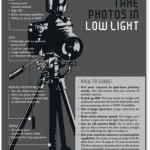Low Light Photography Tips
I receive regular updates from the PictureCorrect website and they are ALL very useful to any photographer, whatever level they are at. The related site at PictureSocial is a place where photographers can set up their own pages and blog, with the ability to add photographs they have taken…One of my posts was taken up a while back as well….which was a great boost!
So – why the intro?!
I received an email this morning from PictureCorrect with the title: Low Light Photography Tips and there is an Infographic that I thought my readers would like – also a chance, for any who are not aquainted with PictureCorrect, to let them know about said sites.

Low Light Photography Tips from PictureCorrect
So the tips given as well as the Infographic:
Low Light Photography Tips by Richard Schneider:
1. Crank up the ISO. The higher the ISO number, the more sensitive the camera’s sensor is to the light that is reaching it. The additional noise that is generated by using a high ISO can be filtered out somewhat in post-processing. Sometimes the extra grain adds a little something special to the shot. Shooting in RAW format allows for the most flexibility in post-processing.
2. Use a larger aperture. The larger the aperture, the more light is entering the lens. Shooting at f/5.6 lets in more light than shooting at f/18 (remember, the lower the number, the larger the aperture).
3. Slow down the shutter speed. More light is captured the longer the shutter remains open. Keep in mind that a good “rule of thumb” for clear hand-held shots is no slower than 1/60th of a second. Use a tripod if you’re shooting at anything slower than that, though I have had success at slower hand-held shots using lenses with image stabilization.
4. If you do have to use a flash, try to avoid the on-camera pop-up. It tends to flatten the appearance of the image because the light is hitting the subject directly. Invest in an off-camera flash, angle light so that it is not directly in front of the subject, and use reflective surfaces and diffusers to soften the light. Strategically placed constant light (such as tungsten lamps using soft white bulbs) work excellently for providing additional ambient light without sacrificing the atmosphere of the setting.
5. Use your camera’s exposure compensation capabilities. The scale on many of today’s DSLR’s allow from -3 to +3 stops in 1/3 stop increments (my 7D is +/-5). Dial the exposure compensation to the positive side to purposefully “overexpose” the photograph.
Information provided courtesy of Snapsort and their article on Low Light Photography.
For Further Training:
Landscape photography at night can be be difficult to capture, but it holds the potential to reveal images beyond what can be seen by the human eye. This popular in-depth guide, which we have an exclusive deal on for only 2 more days, is the product of three intensive years shooting & refining techniques all over the world.
More details here: Landscape Photography at Night
Go to full article: Low Light Photography Tips by Richard Schneider
Those tips are additional to the infographic shown as a scrollable PDF below (there is also a download link and the PDF is sharp as a pin!).
Add your comments to the form below – we would love to hear your thoughts on this well sought after topic!
Download a larger JPG version here (Dimensions: 1000 × 3166)
![]()



